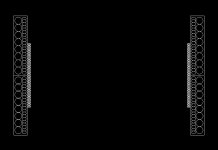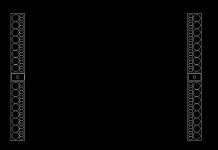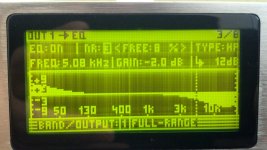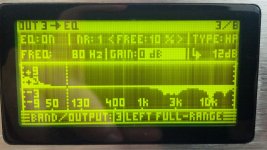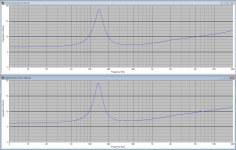I'm still not convinced center to center spacing is the only factor involved. If you look at the length of an array the outer ones are going to be much further away than the ones who are at or around your ear level. So maybe it would be enough to make the tweeter array shorter to prevent combing?
Before I built the arrays, I read about them from curved, louder in the center and tapered power to the edges and then the corner loaded full range line arrays. Since this created more questions than solutions, I went with a 2-way to limit EQ and beaming at the top and ran them all full power like the CLA is wired. My first speaker ran a 4 foot line of tweeters but then I increased it to full length at 6 feet to match the woofers. My reason for this was to increase output of the tweeter line and to make sure at least some of them were on axis when standing up. If a tweeter sitting so close to the floor became an issue, the 6 foot height allows placing it on a stand if the need arises.
The corner loaded line arrays run full power from top to bottom and the designer did not complain about the highs bouncing off the floor, he considered that a good thing. His concept was your ears will reject the off-axis time issues and focus on the first wave to hit the ear drums. Sounds odd on paper so I made some sawdust with full lines to check it out. Much easier to disconnect tweeters if it was a problem (or put the speakers on stands) to even covering tweeters with a 2 x 4 for testing. The tweeter line bounces off the hard, smooth cement floor of the garage but to my ears, it sounds natural although with some music...larger than life.
The arrays were originally just for music while working on things in the garage. They do sound different if you are seated or standing, the treble is still there in any position but it sounds better when seated. I would hazard to guess this has to do with most of the drivers being off axis when standing so the bass would sound stronger for this reason. Laying on the floor still gives strong treble response since the highs are reflecting off a smooth cement floor. The metal garage roof is peaked, has rafters with stuff on it and the peak is around 12 feet up. The 6 foot height of them would probably couple to the 8 foot ceilings in conventional rooms much better so that might have something to do with the change in sound. Have not tested them on carpeting in the house since my latest in big and ugly stays in the garage (WAF = 0)
They do sound their best when the listening distance is twice their height. Getting closer than that causes a frequency shift in bass response so for that reason, I'd not use them for near field monitoring.
Would I blow $1,200 on a crate of full ranges to build a pair of line arrays? At this point, no... they sound great in a garage and I have not experimented with them enough to know if they would suit my tastes in a house. The only way I'll know is to get the tapped horns installed to take care of the bass, run a new EQ to get it smooth then listen for myself. If the beaming from those 5" woofers before it crosses at 4.3 KHz to the tweeter lines bother me, I'll go 3-way. It is worth it to me to get great sound in the garage that also doubles as PA type party speakers, but in a house? That question can only be answered with a crate of 2" mids, some crossover parts and plenty of sawdust generation. When (if?) I do that, I'll drag the heavy things in the house to answer the other questions.
For now, they sound big, they give me the highs when working in the garage and they are loud at low power with great dynamic range and low distortion. People that visit me in the garage for a listen are generally musicians and they do love the big sound--but part of that most likely is due to hearing something unique for the first time. After all, if something is that big and uses 60 speakers per box...it has to sound good. I'm sure if I added 32 mids per box, some thing with 92 drivers would sound even better, right?
gmcalabria:
Again, it's a little more complicated than just taking the C-C spacing and saying "It's going to comb filter above this". In actual fact, you start getting lobes in the far field at the frequency with a wavelength that is equal to the C-C spacing, but the first actual comb "cancellation" doesn't happen until twice that frequency. So in the case of the Vifa drivers, the C-C spacing is 83.75mm which is a frequency of 4100Hz. The first actual cancellation doesn't happen until 8200Hz. That's where the output is going to start to diminish, and where you'll need EQ.
The problem is further compounded by the fact that the driver dispersion is no longer spherical at these high frequencies, and to get comb filtering, you need spherical dispersion. The little drivers start to be become more and more directional at higher frequencies, and this counteracts the effects of combing, much like an array of ribbons would. The reason an array of ribbons doesn't comb filter is because the dispersion patterns of the ribbons don't overlap, meaning there is no cancellation and no combing. All of this is covered in Jim's paper.
The issue you mentioned genuinely doesn't exist thanks to temporal masking:
Temporal masking - Wikipedia, the free encyclopedia
The difference in arrival times between the top driver and the centre driver in your diagram would be 0.56us which is so short that your brain would never be able to distinguish the two arrivals as separate or distinct. The generally accepted minimum value for when your brain can tell the difference is 20ms, so it's not even in the ballpark.
Some people have built curved arrays to account for this, but all they end up doing is making comb filtering worse, and then the array can only be focused on a single point in space, which is pretty restrictive. It's also very difficult to build a perfect curved baffle.
Regards,
Owen
Thank you, Owen
I ran my calculations with my 5 inch woofers with a 143.5mm C to C spacing and it is 2,400 Hz. Twice that is 4,800 Hz which is not an issue as the tweeter lines come in at 4,300 Hz. The tweeter lines have a 36mm C to C for 9,500 Hz or double it for 19,100 Hz. My last hearing test showed 18 KHz as my upper limit so combing at 19+ KHz I'll never hear.
So far so good, it makes more sense since some of the EQ profiles with full ranges don't match my 2-way--not even close! My guess is those 5 inch woofers have issues at the crossover point, they are quoted from 60 Hz to 4,000 Hz in response and I've pushed them to 4,300 Hz. My guess is they are around 5dB down at the 4.3 KHz crossover point and could use some EQ at that point. There is something going on in the 2KHz to 4KHz band which probably relates to the stock driver's response.
My Audio Source sound level/RTA bit the dust when I was going to test the frequency response, such is the DIY life. In the coming weeks I'll get it running again and test for the upper mid response specifically. What type of curve and how narrow the frequency bands are determine what type of Yamaha mixer I'll be purchasing. I know it needs EQ but I hope it does not require 1/3rd octave to get +/- 3dB.
Temporal masking, that explains why it don't sound like an echo box so now I know. After all, the ear and brain do different things to process sound attempting to find the saber toothed tiger in the trees. I consider that a good thing, all speakers sound terrible in theory and a microphone is a very sensitive device.
Here's a kind of test bed design I thought of:
Build the cabinets in pieces with maybe 6 of those cheap furniture 1/4 turn cam-lok posts on top. Match that with locks on the other cabinet. This way, the cam lok will put positive pressure between the cabinet sections. Also, the tweeter line can be... velcro'd. Sounds cheap and awful, but B&W seems to think vibrationally isolating the tweeters is a good idea. Maybe include some dowels to keep the things aligned.
What will really be nice is that I can break up the array and place a tweeter in between the two halves and toss the tweeter array. I'll use 70% of the same parts in both arrays and get to test the pro's and con's of both types without doubling work. Of course, then the line array size must be designed around the tweeter being at ear height.
The only problem here is that the mids and woofers will need to be adjacent. If I want to move to a MTW arrangement, I may have some work to do. BTW, I think that C-C distance between non-similar drivers is something I know little about. I've heard max of crossover frequency wavelength between, but i know little else about that, so I can't tell if MTW or TMW is more desirable for LA's.
Greg
Build the cabinets in pieces with maybe 6 of those cheap furniture 1/4 turn cam-lok posts on top. Match that with locks on the other cabinet. This way, the cam lok will put positive pressure between the cabinet sections. Also, the tweeter line can be... velcro'd. Sounds cheap and awful, but B&W seems to think vibrationally isolating the tweeters is a good idea. Maybe include some dowels to keep the things aligned.
What will really be nice is that I can break up the array and place a tweeter in between the two halves and toss the tweeter array. I'll use 70% of the same parts in both arrays and get to test the pro's and con's of both types without doubling work. Of course, then the line array size must be designed around the tweeter being at ear height.
The only problem here is that the mids and woofers will need to be adjacent. If I want to move to a MTW arrangement, I may have some work to do. BTW, I think that C-C distance between non-similar drivers is something I know little about. I've heard max of crossover frequency wavelength between, but i know little else about that, so I can't tell if MTW or TMW is more desirable for LA's.
Greg
Attachments
Reading this thread caused me a great deal of pain, knowing that I had just cheated when I built my line arrays.
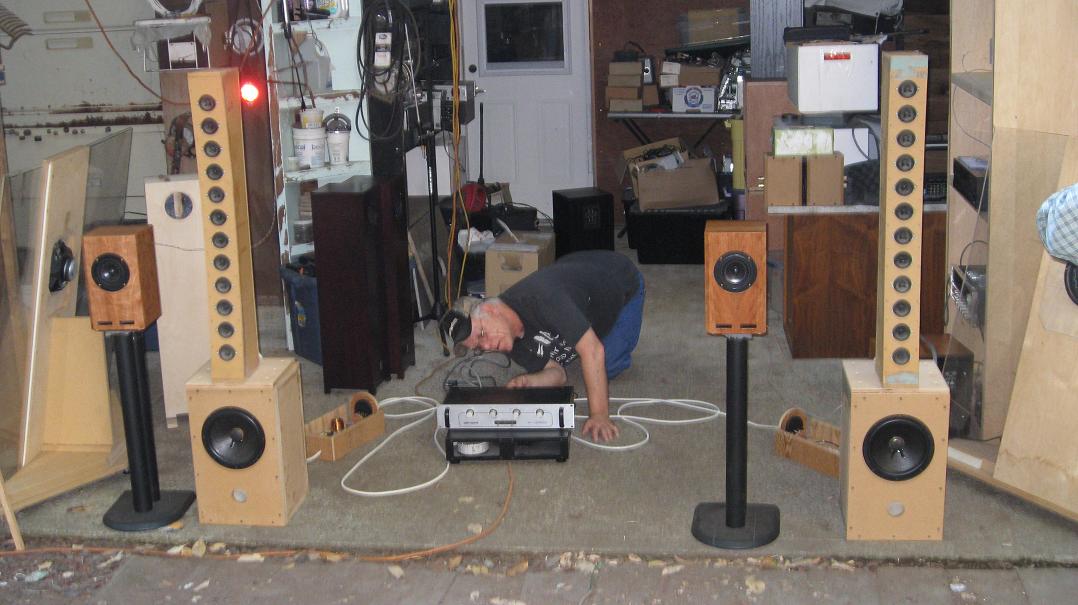
I simply avoided, like the coward that I am, all comb filtering, phase (timing) issues and other problems that I didn't want to deal with. That included tweeters, C2C issues and crossover difficulties were some of the difficulties that I avoided.
The array consists of twelve 1.5 inch (nominal) diameter drivers with some old Adire Audio AV 8 inch woofers crossed over (using a series crossover) at 450 Hz. The Bass unit is tuned to 33 Hz.
Voted "Best Midrange" at the RAW Fest (Canada), Kow Tow award at VSAC and 1st place in the 2-way class at "The Puget Sound! DIY Speaker Contest" (2010).
Total cost is right around $81.00.
Best Regards,
TerryO
I simply avoided, like the coward that I am, all comb filtering, phase (timing) issues and other problems that I didn't want to deal with. That included tweeters, C2C issues and crossover difficulties were some of the difficulties that I avoided.
The array consists of twelve 1.5 inch (nominal) diameter drivers with some old Adire Audio AV 8 inch woofers crossed over (using a series crossover) at 450 Hz. The Bass unit is tuned to 33 Hz.
Voted "Best Midrange" at the RAW Fest (Canada), Kow Tow award at VSAC and 1st place in the 2-way class at "The Puget Sound! DIY Speaker Contest" (2010).
Total cost is right around $81.00.
Best Regards,
TerryO
Last edited:
I like your idea of the velcro tweeter line,
If I decide to go 3-way, I'll cut the tweeter line out of the bezel and do the velcro with pins trick. This will allow the space to make a new bezel to hold the 5" woofers and 3" full ranges as mid-range drivers and cross over at 300Hz. The only way I can stuff a 3" full range in with the woofers is by going external with the tweeters as your design points out.
I'd stuff the tweeter crossover and mid low pass filter in the external tweeter line. This will allow completely bypassing the tweeter line to listen to "full range with helper woofer" type designs. Such a simple design tweak that would solve all my issues--the KISS principle at work.
If I decide to go 3-way, I'll cut the tweeter line out of the bezel and do the velcro with pins trick. This will allow the space to make a new bezel to hold the 5" woofers and 3" full ranges as mid-range drivers and cross over at 300Hz. The only way I can stuff a 3" full range in with the woofers is by going external with the tweeters as your design points out.
I'd stuff the tweeter crossover and mid low pass filter in the external tweeter line. This will allow completely bypassing the tweeter line to listen to "full range with helper woofer" type designs. Such a simple design tweak that would solve all my issues--the KISS principle at work.
Hi TerryO,
I wouldn't call it cheating... sometimes the simplest solution is the best by virtue of avoiding the problems that arise with added complexity
To be honest, it's almost always better to just build something than spend two years worrying about everything that could go wrong and never actually building anything.
In reading a lot of the papers out there on line arrays, you'll quickly notice that most of the writers have some sort of agenda they want to push, and they'll often make a mountain out of an ant hill to try and make their ideas sound like solutions to important problems. People who write about power tapering will make a big fuss about comb filtering, and people who make horns will tell you that controlled directivity is the only thing you need to get good sound. After reading ten articles you might be left thinking "There are so many problems with line arrays that they could never sound good" but that's just not the case.
There is no such thing as a perfect speaker, and it's a futile attempt to target that goal. If you spend you're whole life waiting and researching to build the perfect speaker, you'll miss out on a lot of fun builds!
Cheers,
Owen
I wouldn't call it cheating... sometimes the simplest solution is the best by virtue of avoiding the problems that arise with added complexity
To be honest, it's almost always better to just build something than spend two years worrying about everything that could go wrong and never actually building anything.
In reading a lot of the papers out there on line arrays, you'll quickly notice that most of the writers have some sort of agenda they want to push, and they'll often make a mountain out of an ant hill to try and make their ideas sound like solutions to important problems. People who write about power tapering will make a big fuss about comb filtering, and people who make horns will tell you that controlled directivity is the only thing you need to get good sound. After reading ten articles you might be left thinking "There are so many problems with line arrays that they could never sound good" but that's just not the case.
There is no such thing as a perfect speaker, and it's a futile attempt to target that goal. If you spend you're whole life waiting and researching to build the perfect speaker, you'll miss out on a lot of fun builds!
Cheers,
Owen
Very true.Hi TerryO,
I wouldn't call it cheating... sometimes the simplest solution is the best by virtue of avoiding the problems that arise with added complexity
To be honest, it's almost always better to just build something than spend two years worrying about everything that could go wrong and never actually building anything.
In reading a lot of the papers out there on line arrays, you'll quickly notice that most of the writers have some sort of agenda they want to push, and they'll often make a mountain out of an ant hill to try and make their ideas sound like solutions to important problems. People who write about power tapering will make a big fuss about comb filtering, and people who make horns will tell you that controlled directivity is the only thing you need to get good sound. After reading ten articles you might be left thinking "There are so many problems with line arrays that they could never sound good" but that's just not the case.
There is no such thing as a perfect speaker, and it's a futile attempt to target that goal. If you spend you're whole life waiting and researching to build the perfect speaker, you'll miss out on a lot of fun builds!
Cheers,
Owen
After reading about various projects using NSB (no stinking badges) 4", I bought 16 of them for 50 cents apiece, cut baffles, wired them series parallel, and put them in a pair of sonotubes.
Although the NSB's rolled off above about 12K, the vocal range sounded quite good, and with a fair amount of upper EQ boost and a sub, made a good sounding little PA.
The only place I needed a little PA at closed, and I sold them to a jazz musician who uses them for lounge PA. Vocalists love them, the speakers have smooth enough response they can stand in front of them and hear themselves and cover small clubs with no feedback problems and no EQ.
Later, I bought a pair of Renkus Heinz ICX7 that use coaxial cones and frequency shading, a very complex crossover as well as Zoebles on each woofer and tweeter. The crossover weighs more than the amplifiers in the bi-amp powered version.
The frequency shading put most of the HF power to the center tweeter on the ICX7, which melted and caused the woofer to drag after a few minutes of pink noise testing
Cost for the NSB project was about $75, the ICX7 were over $1500 dealers cost IIRC. One replacement co-ax driver for the ICX7 cost more than the 16 NSB drivers.
Although the ICX7 had a smoother frequency response, the NSBs sounded better, and were about 10 dB more sensitive.
Like you said before, buy some test drivers, choose good ones, and go for it.
Last edited:
Here's another picture of my focused arrays. Yes, I was actually concerned with comb filtering and C2C distance, but I wanted a total solution, not a compromise, to the problem. These were specifically designed for critical listening in my house and not as a general purpose design.
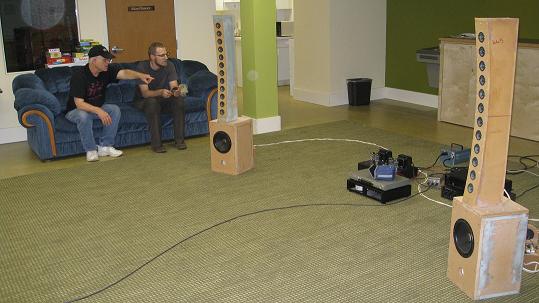
Best Regards,
TerryO
Best Regards,
TerryO
Wow great thread for the past year or so I have been reading about line arrays with a lot of curiosity. I have built my speakers for my HT and the wife is not to happy with them fortunately she loves the way they sound so she has quit complaining. They are the Tri-Trix kit finished in white.
Well now, I am on my next project... the car. After researching for what I wanted to do, I was seeing that a lot of folks are doing a 3 way setups with a Tweet and a 2,3,or 4 inch mid installed into the a-pillars and larger mids in the doors and kick panels of there cars. That seems to open a whole assortment of problems of what to do and not to do, on axis off axis on axis mid’s and off axis tweet’s...ect. Time alignment and tons of EQ are the norm and necessary for such installations. So now, my head is swimming with ideas. Some are now running line arrays’ on the A-pillar with MTM or several 1-inch drivers. Therefore, that got me to thinking what about a horizontal line array did a search and found that. Patrick Bateman has touched on this subject in a few threads as well as others.
L R
I took some measurements and I can get away with a 3 inch driver on the dash, well I have decided to build it fingers crossed it will work ok. I am going with the a MMMTMMM--------MMMTMMM on the dash. The drive I chose is Tang Band W3-881SI 3" Speaker and a Vifa BC25SC06-04 1" Textile Dome Tweeter. I figure I could use a 7 or 10-band EQ. Not sure if I will in fact need a tweeter. Should I run the TB’s on one channel of the amp and the vifa’s on second channel or can I just use a simple cap on the tweet and run the Horizontal Line Array on one channel? I placed the order a few days ago and I am looking forward to this experiment and who knows it may work like a champ once I figure out the finer details. This is my first dive into custom speaker building I cannot count the Tri-Trix kit that was a screw and glue kit. So if anyone has some suggestions I am all ears.
Respectfully,
Phil
Well now, I am on my next project... the car. After researching for what I wanted to do, I was seeing that a lot of folks are doing a 3 way setups with a Tweet and a 2,3,or 4 inch mid installed into the a-pillars and larger mids in the doors and kick panels of there cars. That seems to open a whole assortment of problems of what to do and not to do, on axis off axis on axis mid’s and off axis tweet’s...ect. Time alignment and tons of EQ are the norm and necessary for such installations. So now, my head is swimming with ideas. Some are now running line arrays’ on the A-pillar with MTM or several 1-inch drivers. Therefore, that got me to thinking what about a horizontal line array did a search and found that. Patrick Bateman has touched on this subject in a few threads as well as others.
L R
I took some measurements and I can get away with a 3 inch driver on the dash, well I have decided to build it fingers crossed it will work ok. I am going with the a MMMTMMM--------MMMTMMM on the dash. The drive I chose is Tang Band W3-881SI 3" Speaker and a Vifa BC25SC06-04 1" Textile Dome Tweeter. I figure I could use a 7 or 10-band EQ. Not sure if I will in fact need a tweeter. Should I run the TB’s on one channel of the amp and the vifa’s on second channel or can I just use a simple cap on the tweet and run the Horizontal Line Array on one channel? I placed the order a few days ago and I am looking forward to this experiment and who knows it may work like a champ once I figure out the finer details. This is my first dive into custom speaker building I cannot count the Tri-Trix kit that was a screw and glue kit. So if anyone has some suggestions I am all ears.
Respectfully,
Phil
Yepvegas:
Sorry, I don't think I can help here. I stay far away from car audio since better speakers=more weight=slower (I autocross/hope to start track soon). That's my excuse, at least.
Ok, so, I picked 8 sets of mids/woofers. The exciting ones are:
OPC's Vifas (more as a benchmark)
Aura NS3's, NS525's, NS6's
PE Buyout 5" concave cone, P/N 299-289
PE Buyout 6.5" Focal 6M115, P/N 299-155 (there are curves available, not sure how accurate they are)
OPC, I can see why you went with the Vifas if you're going full range. If you can get bass out of them in a line array and tame that top end, they're pretty nice. Then again, I'm still planning to go 2-way and for a lower price.
I do like the NS6's, but I'm really impressed with the Focal and the 5" concave 2 ohm drivers. They both have more punch than my Avid 102's (don't judge) and more inner texture/subtlety. The Focal I kindof expected given Focal's rep (yes, I know these are cheap OEM jobs), but the 5" drivers are so cheap I didn't expect much. They've got great bass for a 5", very bass-ey. Fuller and smoother than the Focal, though maybe with slightly less inner detail than the Focals. The smaller size will make 2-way a possibility, where I think the Focals are well out of that range.
That said, I've not tried mounting them to a baffle or anything, I'm just holding on to these at the tweeters with both hands. So these tests probably don't mean much of anything.
I did try running 2-way crossovers with some tweeters I had laying around. I mainly ran those $5 Sinar Baja (SB Acoustics) fabric dome tweeters on Madisound and designed the x-over on J Bagby's Excel program.
As for the NS3s, they're definitely not up to par with the Vifas, but pretty good considering they're only $2. If those Vifas came out so well, I'd be tempted to use the NS3s for a cheap PA application. Then again, this is HT, not PA.
The NS525's are no let-down either. Again, not as good as other choices, but they're pretty solid overall.
I'll be trying some 3-way setups with the Aura NS2x3's that I got. Those 2x3's are too expensive for what they are, but I'm hoping that Madisound may give me a special bulk deal on them since I'd be buying a boatload. We'll see.
Greg
Sorry, I don't think I can help here. I stay far away from car audio since better speakers=more weight=slower (I autocross/hope to start track soon). That's my excuse, at least.
Ok, so, I picked 8 sets of mids/woofers. The exciting ones are:
OPC's Vifas (more as a benchmark)
Aura NS3's, NS525's, NS6's
PE Buyout 5" concave cone, P/N 299-289
PE Buyout 6.5" Focal 6M115, P/N 299-155 (there are curves available, not sure how accurate they are)
OPC, I can see why you went with the Vifas if you're going full range. If you can get bass out of them in a line array and tame that top end, they're pretty nice. Then again, I'm still planning to go 2-way and for a lower price.
I do like the NS6's, but I'm really impressed with the Focal and the 5" concave 2 ohm drivers. They both have more punch than my Avid 102's (don't judge) and more inner texture/subtlety. The Focal I kindof expected given Focal's rep (yes, I know these are cheap OEM jobs), but the 5" drivers are so cheap I didn't expect much. They've got great bass for a 5", very bass-ey. Fuller and smoother than the Focal, though maybe with slightly less inner detail than the Focals. The smaller size will make 2-way a possibility, where I think the Focals are well out of that range.
That said, I've not tried mounting them to a baffle or anything, I'm just holding on to these at the tweeters with both hands. So these tests probably don't mean much of anything.
I did try running 2-way crossovers with some tweeters I had laying around. I mainly ran those $5 Sinar Baja (SB Acoustics) fabric dome tweeters on Madisound and designed the x-over on J Bagby's Excel program.
As for the NS3s, they're definitely not up to par with the Vifas, but pretty good considering they're only $2. If those Vifas came out so well, I'd be tempted to use the NS3s for a cheap PA application. Then again, this is HT, not PA.
The NS525's are no let-down either. Again, not as good as other choices, but they're pretty solid overall.
I'll be trying some 3-way setups with the Aura NS2x3's that I got. Those 2x3's are too expensive for what they are, but I'm hoping that Madisound may give me a special bulk deal on them since I'd be buying a boatload. We'll see.
Greg
Wow, now that I've tried EQing both the Vifa and the NS3s (I mean the cheap $2.50 paper NS3, not the aluminum cone NS3), I'm impressed with both. The Vifa is definitely a better speaker all around, especially in the lower midrange and sibilance, but if there's anyone that wants to copy OPC's arrays but doesn't want to spend the money, the NS3 is really solid. Impressively so, considering the 1/6th price tag. See attached EQ's. Please note, there is another -15 dB high-pass filter @80hz in order to compensate for the bass, not shown because the Behringer's screen will not show anything more than +/-15 dB.
That said, in comparing these against any of the 2-way setups with larger woofers with a tweeter, A-B style, I like the fullness of the 2 way (not surprising), but I also like the natural, effortless treble/air and detail from the tweeter. Maybe I'm hunting for excuses not to go full range here. In the bass realm, I think that the less hard a speaker works (less excursion) the better. The best bass in a speaker that I own is my old Rectilinear III's, and that 12" moves WAY less than my 12" subwoofers on my HT system and sounds WAY better. The fact that the 5" has a tiny xmax is irrelevant because it won't need as much as the Vifa will anyway, yet they still has more.
I'll be testing out some 3-way setups here soon, but if I had to pick a setup right now, I'd go with the little 5" concave cone speakers. They're nearly as good as the Focal or Aura but considerably cheaper and small enough to get away without much/any comb filtering. 5" C-C means lambda at 2700 Hz, no audible combing until 5400 Hz, well into the tweeter's range. The Aura is around 2300/4600 and the Focal is 2050/4100, which seems marginal, especially at upper midrange/lower treble frequencies. 3-way would fix that.
BTW, OPC, you said that series drivers shouldn't share a cabinet. Why's that?
Greg
That said, in comparing these against any of the 2-way setups with larger woofers with a tweeter, A-B style, I like the fullness of the 2 way (not surprising), but I also like the natural, effortless treble/air and detail from the tweeter. Maybe I'm hunting for excuses not to go full range here. In the bass realm, I think that the less hard a speaker works (less excursion) the better. The best bass in a speaker that I own is my old Rectilinear III's, and that 12" moves WAY less than my 12" subwoofers on my HT system and sounds WAY better. The fact that the 5" has a tiny xmax is irrelevant because it won't need as much as the Vifa will anyway, yet they still has more.
I'll be testing out some 3-way setups here soon, but if I had to pick a setup right now, I'd go with the little 5" concave cone speakers. They're nearly as good as the Focal or Aura but considerably cheaper and small enough to get away without much/any comb filtering. 5" C-C means lambda at 2700 Hz, no audible combing until 5400 Hz, well into the tweeter's range. The Aura is around 2300/4600 and the Focal is 2050/4100, which seems marginal, especially at upper midrange/lower treble frequencies. 3-way would fix that.
BTW, OPC, you said that series drivers shouldn't share a cabinet. Why's that?
Greg
Attachments
Hi Greg,
You're definitely on the right track with your experiments! Kudos for taking the time to actually evaluate the drivers you're interested in. It's amazing how much you can learn from just listening and trying a few different setups.
Your observations also seem to be spot-on with what I heard. With a single driver, and even with EQ, they still have that traditional "full range" sound where 80% of the spectrum sounds great, but the 10% missing at either extreme really makes them less pleasant to listen to. A single driver will have almost no bottom end, and the top end does roll off. I found the vifa to be one of the best in the extreme top end, where you still do get that airy sparkle that you get with a tweeter, but it is a little more muted than it would be with a tweeter.
Trying to ignore the bottom end was the biggest challenge for me when evaluating the single drivers. I knew that in an array it would be significantly better, but it's hard to listen to something with no content below 100Hz and be objective about it.
I can assure you that once you get the array built, you certainly won't have any lack of bottom end extension, and the top end can get pretty close to perfect with the right EQ. You'll never get quite on par with a good ribbon for general openness and air, but it's close enough, and easily bests the top end on many systems with tweeters.
As an aside, I sent two of the Vifa drivers to Zaph for testing in his latest round-up, and I got the results back the other day. It measures very well, but he has yet to post it on his site, so I'll have to wait to hear back from him before sharing the results.
As for the series drivers in a sealed box, I actually don't understand from a technical standpoint what the issue is. What I do know is that when I was working for Paradigm, one of the products had 6 drivers in a sealed volume and the acoustic designer went to great trouble to make sure all 6 drivers were wired up in parallel. It was explained to me second hand that they had tried in the past to run series/parallel combinations in a sealed volume, and that at higher outputs the drivers wouldn't share power/excursion equally and the system would become unstable and damage one of the drivers. Apparently the only way around it was to wire all the drivers in parallel when in a shared sealed volume.
Maybe someone here with a little more eletromechanical background could elaborate.
Cheers,
Owen
You're definitely on the right track with your experiments! Kudos for taking the time to actually evaluate the drivers you're interested in. It's amazing how much you can learn from just listening and trying a few different setups.
Your observations also seem to be spot-on with what I heard. With a single driver, and even with EQ, they still have that traditional "full range" sound where 80% of the spectrum sounds great, but the 10% missing at either extreme really makes them less pleasant to listen to. A single driver will have almost no bottom end, and the top end does roll off. I found the vifa to be one of the best in the extreme top end, where you still do get that airy sparkle that you get with a tweeter, but it is a little more muted than it would be with a tweeter.
Trying to ignore the bottom end was the biggest challenge for me when evaluating the single drivers. I knew that in an array it would be significantly better, but it's hard to listen to something with no content below 100Hz and be objective about it.
I can assure you that once you get the array built, you certainly won't have any lack of bottom end extension, and the top end can get pretty close to perfect with the right EQ. You'll never get quite on par with a good ribbon for general openness and air, but it's close enough, and easily bests the top end on many systems with tweeters.
As an aside, I sent two of the Vifa drivers to Zaph for testing in his latest round-up, and I got the results back the other day. It measures very well, but he has yet to post it on his site, so I'll have to wait to hear back from him before sharing the results.
As for the series drivers in a sealed box, I actually don't understand from a technical standpoint what the issue is. What I do know is that when I was working for Paradigm, one of the products had 6 drivers in a sealed volume and the acoustic designer went to great trouble to make sure all 6 drivers were wired up in parallel. It was explained to me second hand that they had tried in the past to run series/parallel combinations in a sealed volume, and that at higher outputs the drivers wouldn't share power/excursion equally and the system would become unstable and damage one of the drivers. Apparently the only way around it was to wire all the drivers in parallel when in a shared sealed volume.
Maybe someone here with a little more eletromechanical background could elaborate.
Cheers,
Owen
Hi Greg,
You're definitely on the right track with your experiments! Kudos for taking the time to actually evaluate the drivers you're interested in. It's amazing how much you can learn from just listening and trying a few different setups.
Your observations also seem to be spot-on with what I heard. With a single driver, and even with EQ, they still have that traditional "full range" sound where 80% of the spectrum sounds great, but the 10% missing at either extreme really makes them less pleasant to listen to. A single driver will have almost no bottom end, and the top end does roll off. I found the vifa to be one of the best in the extreme top end, where you still do get that airy sparkle that you get with a tweeter, but it is a little more muted than it would be with a tweeter.
Trying to ignore the bottom end was the biggest challenge for me when evaluating the single drivers. I knew that in an array it would be significantly better, but it's hard to listen to something with no content below 100Hz and be objective about it.
I can assure you that once you get the array built, you certainly won't have any lack of bottom end extension, and the top end can get pretty close to perfect with the right EQ. You'll never get quite on par with a good ribbon for general openness and air, but it's close enough, and easily bests the top end on many systems with tweeters.
As an aside, I sent two of the Vifa drivers to Zaph for testing in his latest round-up, and I got the results back the other day. It measures very well, but he has yet to post it on his site, so I'll have to wait to hear back from him before sharing the results.
As for the series drivers in a sealed box, I actually don't understand from a technical standpoint what the issue is. What I do know is that when I was working for Paradigm, one of the products had 6 drivers in a sealed volume and the acoustic designer went to great trouble to make sure all 6 drivers were wired up in parallel. It was explained to me second hand that they had tried in the past to run series/parallel combinations in a sealed volume, and that at higher outputs the drivers wouldn't share power/excursion equally and the system would become unstable and damage one of the drivers. Apparently the only way around it was to wire all the drivers in parallel when in a shared sealed volume.
Maybe someone here with a little more eletromechanical background could elaborate.
Cheers,
Owen
I have asked Mr. Russell about sharing the volume with the series paralell drivers and he didn't experience any drawbacks. He mentioned the impedance curve of all drivers sharing the volume matched that of an individual driver.
I hope to see the graphs of those vifa drivers someday soon as I have a box of 50 here waiting to be used.
You are right about the bass part missing while listening to a single driver, makes it hard to know what to expect from an entire array.
Another question Owen, did you ever test the distortion on the entire array in the bass region, say at 50 Hz? I have an older test of this driver from a german magazine that shows distortion plots. Very clean but obviously rising on the lower frequencies. But compared to the Vifa's in the IDS-25 it is very similar. Just wondering how it behaves with the boosting in the lows...
...Maybe someone here with a little more eletromechanical background could elaborate...
Many drivers sharing the same cabinet resembles a Multi DOF System if they are mechanically different.. IME max 4 T/S matched drivers survives over time when used in arrays.
Multi DOF:
Multiple DOF Systems
b
Hi Guys,
I spoke to John and he said it was fine to post the results here for the Vifa driver, so I've attached them below.
It really does measure exceptionally well, especially in the context of fullrange use. The copper in the motor keeps the inductance remarkably low, which makes the impedance curve very flat, staying below 11 ohms up to 20kHz.
The frequency response is very smooth and extended, and distortion is very good above about 200Hz. THD does climb below that, but that's to be expected for a driver this small.
Hope this is helpful for anyone looking at these.
Regards,
Owen
I spoke to John and he said it was fine to post the results here for the Vifa driver, so I've attached them below.
It really does measure exceptionally well, especially in the context of fullrange use. The copper in the motor keeps the inductance remarkably low, which makes the impedance curve very flat, staying below 11 ohms up to 20kHz.
The frequency response is very smooth and extended, and distortion is very good above about 200Hz. THD does climb below that, but that's to be expected for a driver this small.
Hope this is helpful for anyone looking at these.
Regards,
Owen
Attachments
-
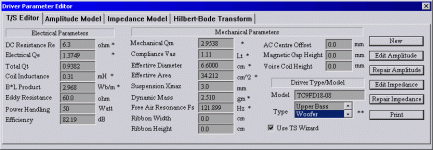 Vifa-TC9FD18-08-TS.gif13.8 KB · Views: 232
Vifa-TC9FD18-08-TS.gif13.8 KB · Views: 232 -
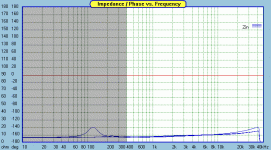 Vifa-TC9FD18-08-Le(x).gif12.8 KB · Views: 195
Vifa-TC9FD18-08-Le(x).gif12.8 KB · Views: 195 -
 Vifa-TC9FD18-08-IMP.gif6 KB · Views: 170
Vifa-TC9FD18-08-IMP.gif6 KB · Views: 170 -
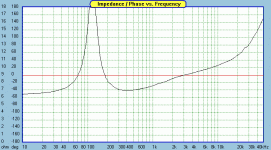 Vifa-TC9FD18-08-IMP-2-sample2.gif11.5 KB · Views: 188
Vifa-TC9FD18-08-IMP-2-sample2.gif11.5 KB · Views: 188 -
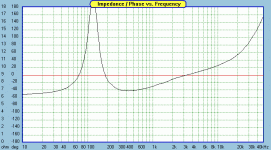 Vifa-TC9FD18-08-IMP-2.gif11.5 KB · Views: 267
Vifa-TC9FD18-08-IMP-2.gif11.5 KB · Views: 267 -
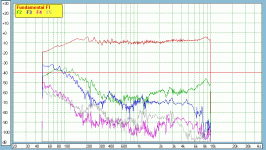 Vifa-TC9FD18-08-HD.gif21.6 KB · Views: 293
Vifa-TC9FD18-08-HD.gif21.6 KB · Views: 293 -
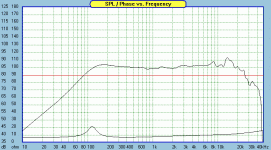 Vifa-TC9FD18-08-FR-sample2.gif11.5 KB · Views: 931
Vifa-TC9FD18-08-FR-sample2.gif11.5 KB · Views: 931 -
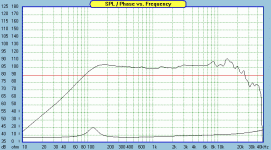 Vifa-TC9FD18-08-FR.gif11.6 KB · Views: 1,362
Vifa-TC9FD18-08-FR.gif11.6 KB · Views: 1,362 -
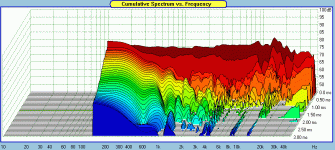 Vifa-TC9FD18-08-CSD.gif30.7 KB · Views: 952
Vifa-TC9FD18-08-CSD.gif30.7 KB · Views: 952
It really does measure exceptionally well, especially in the context of fullrange use. The copper in the motor keeps the inductance remarkably low, which makes the impedance curve very flat, staying below 11 ohms up to 20kHz.
The frequency response is very smooth and extended, and distortion is very good above about 200Hz. THD does climb below that, but that's to be expected for a driver this small.
Owen/John,
Thanks for the info. That Vifa is definitely a quality driver, no doubt about it.
I'd expect that there's an exponential relationship between THD and dB output at any given frequency, which given that SPL's are already exponential, this would be...more exponential? (I should know this, I'm an engineer for heaven's sake). What I mean is, I would expect more than a 10dB drop in distortion levels if the speakers were measured again at 10dB lower volumes. That is the advantage of line arrays/horns, right?
So by that, I'd expect a line array's low end distortion to not be as big an issue. Then again, is the sub-200 Hz SPL output really that low on these drivers? The bass is boosted to extremely high levels compared to the rest of the spectrum. Owen, you've stated that the arrays won't take PA volumes unless you take away some of the low frequency boost. So if the whole array is loud, but not so much that you can very easily run reference volumes on action movies without lessening the bass boost, then we're back to worrying about sub 200 Hz distortion levels. That would be my biggest concern running the 3"ers down to 20Hz. I'd rather use a driver that is more effortless.
I'd really like to compare the Aura NS3's distortion levels against the Vifa 3.5", but John has already warned against comparing distortion levels over different testing methods. I'll take a serious listen tonight to see what the audible differences are. If the Aura does ok on the low end, then a 2-way with the Apex JR tweeters would be nice. Every time I think about building cabinets for a 3-way array I get heartburn.
Greg
Owen/John,
I'd really like to compare the Aura NS3's distortion levels against the Vifa 3.5", but John has already warned against comparing distortion levels over different testing methods. I'll take a serious listen tonight to see what the audible differences are. If the Aura does ok on the low end, then a 2-way with the Apex JR tweeters would be nice. Every time I think about building cabinets for a 3-way array I get heartburn.
Greg
After messing with the Sony 5" neo woofer/Apex Jr. tweeter lines for awhile, my plan is to run NS3's for mids. The 12 Sony woofers crossing to the 21 NS3 mids at 400Hz then to the Apex Jrs at 4,300Hz third order. The way I'm preventing heartburn is to cut the 48 Apex Jr. array off the old bezel then attach it to the side of the speaker. Cutting 12 new woofer holes and 21 NS3 mid holes per baffle will be much better that dealing with the tweeter lines (again)
The Sony 5" Neodymium woofers sound very good in the bass department went operated in a sealed box. The plumber's putty trick worked well on the
thing frames but things get a little weird over 1KHz--the NS3's should handle that with no problem on their way up to 4,300Hz to the Apex Jrs. At least the 80mm frame size matches the 4,300Hz wavelength so anything over one wavelength only becomes an issue over 10KHz with the Apex Jrs.
Although the idea of a 12/21/48 3-way line array makes me cringe, the tweets don't need a enclosure so the project got the green light. Cutting 66 holes is much easier than cutting 162 of them! The Roto-Zip with circle cutter is warming up in the pits.
When I originally completed the arrays--I said I'd never build another one. Technically true but 66 round holes and wiring is much easier than 96 odd holes that needed to be ground down for the tweeters to fit. The hole saw to Roto-Zip to expand the hole and final Dremel of each hole got really old pretty quick! If you can find a 1 & 1/8th hole saw BUY IT and it will save you a lot of time--trust me! Silicone is your friend.
You guys really need to find a local sign shop with a CNC router! I got all my baffles cut out perfectly, countersinks and all for the funny shaped Vifa baskets, for a meager $75. It was the best $75 I've ever spent, and it makes the worst part of building a line array a walk in the park!
All I had to do was get the router out with a chamfer bit and chamfer the inside edge of each hole for better airflow. That made a lot of dust, but only took about 30 minutes.
Cutting all of those holes out by hand would not be a fun job!
I've attached two goodies I found going through my project folder. One is the panel drawing for CNC machining of the front baffles (PDF) and the other is a neat impedance curve showing the impedance of the full line against the impedance of a single driver. It's amazing how little change there is, which is a testament to the driver consistency!
Cheers,
Owen
All I had to do was get the router out with a chamfer bit and chamfer the inside edge of each hole for better airflow. That made a lot of dust, but only took about 30 minutes.
Cutting all of those holes out by hand would not be a fun job!
I've attached two goodies I found going through my project folder. One is the panel drawing for CNC machining of the front baffles (PDF) and the other is a neat impedance curve showing the impedance of the full line against the impedance of a single driver. It's amazing how little change there is, which is a testament to the driver consistency!
Cheers,
Owen
Attachments
After messing with the Sony 5" neo woofer/Apex Jr. tweeter lines for awhile, my plan is to run NS3's for mids. The 12 Sony woofers crossing to the 21 NS3 mids at 400Hz then to the Apex Jrs at 4,300Hz third order. The way I'm preventing heartburn is to cut the 48 Apex Jr. array off the old bezel then attach it to the side of the speaker. Cutting 12 new woofer holes and 21 NS3 mid holes per baffle will be much better that dealing with the tweeter lines (again)
The Sony 5" Neodymium woofers sound very good in the bass department went operated in a sealed box. The plumber's putty trick worked well on the
thing frames but things get a little weird over 1KHz--the NS3's should handle that with no problem on their way up to 4,300Hz to the Apex Jrs. At least the 80mm frame size matches the 4,300Hz wavelength so anything over one wavelength only becomes an issue over 10KHz with the Apex Jrs.
Although the idea of a 12/21/48 3-way line array makes me cringe, the tweets don't need a enclosure so the project got the green light. Cutting 66 holes is much easier than cutting 162 of them! The Roto-Zip with circle cutter is warming up in the pits.
When I originally completed the arrays--I said I'd never build another one. Technically true but 66 round holes and wiring is much easier than 96 odd holes that needed to be ground down for the tweeters to fit. The hole saw to Roto-Zip to expand the hole and final Dremel of each hole got really old pretty quick! If you can find a 1 & 1/8th hole saw BUY IT and it will save you a lot of time--trust me! Silicone is your friend.
18,
I DEFINITELY plan on having the baffles CNC'd for that reason, in fact, I'm hoping to flush mount the tweeters. As for separate cabs for mids and woofers, I considering using the slice stack method previously introduced here. It would make breaking the unit down into smaller sections much easier, and I could irregularly shape the inside of the cabinet for internal reflections much easier. I was considering two volumes shaped like the cross section of the 800 Diamond series B&W, nested inside one another. Not sure if there's a good way to do that mathematically or if general shape is acceptable.
As for 3-way, I've had no problems trying to integrate the NS3 as a mid (again, I'm talking about the $1.50 paper one). I thought it did very well, played pretty naturally and has a clear, a decent presence and detail to it. Then again, if I go that way, should I use an NS525 for the bass? Why not just step up to the NS6 or Focal 6.5"? I understand the Focal needs a large cab to move, even sealed (.75 ft^3 each driver), but it is cheaper (and possibly just a hair nicer) than the NS6.
Then, cost becomes a problem again. The NS6 isn't exactly a rich man's woofer, but it's expensive enough for 16 of them to push me towards the 5.25. I'm running a mid from possibly as low as 800+, then I might as well run a nice sized woofer and let the woofers take it a little easier on the bass notes. I do have a digital x-over, so I'll be running the bass boost trick that Owen is using. If 3"ers do it well, then 5.25"ers do it well, and maybe I'll save the NS6's for something a little grander, like a ribbon stack (or maybe that ESS Airmotion stack I'm dreaming of).
Greg
Off topic, but what does an amp that's been abused sound like? I've been using my old 7.1 H/K receiver with each channel running directly to a separate amp in the unit, so a tri-amp-in-a-box deal. I ran those 2 ohm speakers (I was trying to be good) a little loud when I accidentally ran them quite loud after hooking them up. The amp shut off immediately (over-amp). Since then those amps have been making a noise on very heavy bass notes that sounds like the speaker hitting its mechanical limits, even when the signal isn't clipping and the speakers aren't near their excursion limits. Does it sound like I fried the amps? Would those (the front channels) still be good for tweeters since they don't have large peaks in output? or am I just asking for blown tweeters?
Greg
Greg
- Home
- Loudspeakers
- Multi-Way
- Stupid Cheap Line Array
